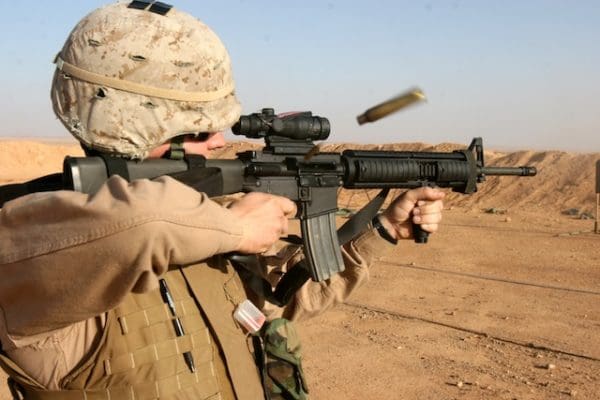It’s the Marine Corps’ fault. They were the ones who got this whole mess confused. It might not be doctrinal Marine Corps training, but it is the training taught by NCOs to junior troops. Even Primary Marksmanship Instructors teach it.
The Bindon Aiming Concept (BAC) is easily the most misunderstood firearms concept out there currently, and it’s largely because the USMC teaches Marines the wrong thing. I know because they taught me and if you look hard enough into the early days of my writing about guns, I’ve likely described it in the wrong way myself. So forgive me, but consider this to be my attempt at redemption, if you will.
What The Bindon Aiming Concept Is
The BAC is a shooting technique designed to allow you to track a moving target in the field. It’s a technique that requires an illuminated reticle. With both eyes opened you track the target by focusing with your off eye while keeping the reticle on or close to the target.
Once it comes time to shoot your target, you switch focus to your dominant eye through the optic. Now you have the precise magnified view and can exercise proper shot placement. It’s simple, effective, and very useful.
While it’s not hard, learning to rapidly change focus between your eyes on target at different distances might be a bit jarring at first. The more you do it, the faster and more comfortable it will become.
What the Bindon Aiming Concept Isn’t
I (and many Marines) was taught that the Bindon Aiming Concept (BAC) was a two-eyes-open shooting method used with magnified optics for close quarter’s shooting. The USMC issued ACOGs, and largely still do and this fixed 4-power optic is an amazing combat rifle optic.
You see, we were taught that at close range the Bindon Aiming Concept was keeping both eyes open while shooting. The bright red reticle would be superimposed over the target and we could accurately engage targets without the optic’s magnification getting in the way at anywhere from 1 to 25 yards.
This is not the Bindon Aiming Concept. This is something of a non-occluded occluded shooting method. Occluded shooting was a very early concept in which a rifle ‘optic’ was not a device you could see through. Instead the optic’s objective cap is on and the shooter used both eyes open to superimpose the illuminated red dot in the center of the shooter’s vision.
You can see through an ACOG so technically that’s not occluded shooting, but the method remains the same and remains effective. Although some prefer to cover the front lens, I’ve never found this necessary as long as I can focus with my off eye. It’s the same method you’d use with a mud-covered red dot optic.
The confusion about the system is due to a number of reasons. First, the BAC is defined as a two-eyes-open shooting concept. Second. Glyn Bindon was the sole importer of the Armson OEG occluded red dot optic. He’s tied to both and he pushed both the BAC and occluded shooting methods. Third, you can use both an occluded shooting technique and the BAC with the Marine’s beloved ACOG.
Confusing Times
Both the occluded shooting technique and BAC have a lot in common, but they are distinctly different. Most people likely use them instinctively without ever knowing which is which, or even what they are called. I hope this clears up some of the non-existent confusion many may have had.
